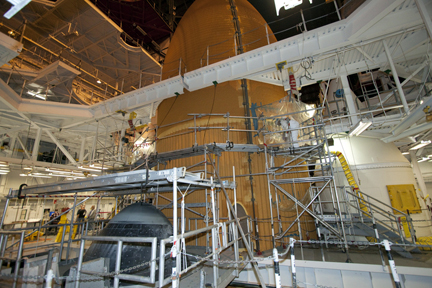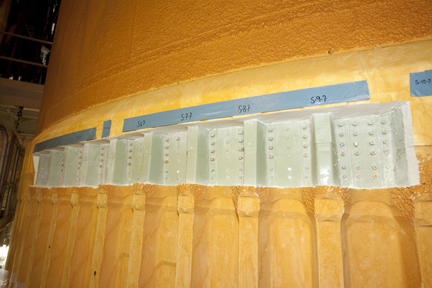NASA rules out early February launch for shuttle Discovery
By WILLIAM HARWOOD
CBS News
KENNEDY SPACE CENTER, FL--NASA managers Thursday decided to give engineers additional time to assess external tank cracks and repair scenarios, ruling out an early February launch for the shuttle Discovery. The next shuttle launch window opens Feb. 27, but NASA is assessing whether it might be possible to move that up a few days.
Additional meetings are planned next week to review progress with already-ordered crack repairs, potential work to beef up other structural ribs, or stringers, in the external tank and the results of an on-going analysis into the root cause of the eight cracks discovered to date. A new target launch date is expected after a program requirements control board meeting Jan. 13 at the Johnson Space Center in Houston.
The next shuttle launch window, the one NASA managers ruled out Thursday, opens Feb. 3 and closes Feb. 10. The next window after that opens Feb. 27 and closes March 6.
The opening of the late-February window is based on plans by the European Space Agency to launch an unmanned cargo ship Feb. 15 to deliver critical supplies to the International Space Station. The normal flight plan calls for ESA's Automated Transfer Vehicle to dock with the lab complex on Feb. 26, clearing the way for Discovery to take off the next day.
If the ATV rendezvous profile can be compressed, it may be possible to launch Discovery a few days ahead of Feb. 27. But as of this writing, it's not yet clear whether that's a viable scenario.
NASA had hoped to launch Discovery on Nov. 1. But the flight was delayed by unrelated technical problems and finally, on Nov. 5, by a gaseous hydrogen leak in a 7-inch vent line quick-disconnect fitting on the side of the external tank.
During work to drain the tank, engineers spotted cracks in its foam insulation near the top of the intertank compartment that separates the tank's hydrogen and oxygen sections. When the damaged foam was removed, four cracks were found in two adjacent stringers near the tank's left-side booster attachment thrust panel, which helps carry the load during launch.
After an instrumented fueling test Dec. 17 to collect data on how exposure to ultra-low temperatures affects the intertank stringers, Discovery was moved back to the Vehicle Assembly Building for additional inspections. Four more small cracks on three stringers were found on the opposite side of the tank from the shuttle on Dec. 29.
The four cracks discovered in the wake of the Nov. 5 launch scrub were repaired by splicing in pristine stringer segments and attaching doublers to provide additional strength. The same repair was ordered for the cracks discovered in the VAB. Because engineers have not been able to determine a root cause, NASA managers also ordered so-called radius block stiffeners attached to another 32 stringers to either side of the two booster attachment thrust panels.
The intertank is built with 108 stringers and NASA managers are considering whether to install radius blocks all the way around the circumference of the external tank to ensure an adequate safety margin. While a single root cause of the cracks has not been determined, it appears the stringers in question were made using an aluminum alloy from a batch produced in 2002 that has a mottled appearance and may not be as strong as engineers expected.
With the addition of the radius block modification, testing indicates the tank's structural safety margin will be more than adequate. But engineers need to make sure the modifications have no unintended consequences and the analysis is not yet complete.
CBS News
KENNEDY SPACE CENTER, FL--NASA managers Thursday decided to give engineers additional time to assess external tank cracks and repair scenarios, ruling out an early February launch for the shuttle Discovery. The next shuttle launch window opens Feb. 27, but NASA is assessing whether it might be possible to move that up a few days.
 |
| NASA managers have ruled out a launch for the shuttle Discovery in early February to give engineers more time to assess cracks in the ship's external tank and possible repair scenarios. The next window opens Feb. 27, although it may be possible to move that up a few days. (Photo: NASA) |
The next shuttle launch window, the one NASA managers ruled out Thursday, opens Feb. 3 and closes Feb. 10. The next window after that opens Feb. 27 and closes March 6.
The opening of the late-February window is based on plans by the European Space Agency to launch an unmanned cargo ship Feb. 15 to deliver critical supplies to the International Space Station. The normal flight plan calls for ESA's Automated Transfer Vehicle to dock with the lab complex on Feb. 26, clearing the way for Discovery to take off the next day.
If the ATV rendezvous profile can be compressed, it may be possible to launch Discovery a few days ahead of Feb. 27. But as of this writing, it's not yet clear whether that's a viable scenario.
NASA had hoped to launch Discovery on Nov. 1. But the flight was delayed by unrelated technical problems and finally, on Nov. 5, by a gaseous hydrogen leak in a 7-inch vent line quick-disconnect fitting on the side of the external tank.
 |
| Foam insulation has been removed from structural ribs, or stringers, in the intertank section of the shuttle Discoery's external tank, clearing the way for installation of stiffeners near booster attachment thrust panels. (Photo: NASA) |
After an instrumented fueling test Dec. 17 to collect data on how exposure to ultra-low temperatures affects the intertank stringers, Discovery was moved back to the Vehicle Assembly Building for additional inspections. Four more small cracks on three stringers were found on the opposite side of the tank from the shuttle on Dec. 29.
The four cracks discovered in the wake of the Nov. 5 launch scrub were repaired by splicing in pristine stringer segments and attaching doublers to provide additional strength. The same repair was ordered for the cracks discovered in the VAB. Because engineers have not been able to determine a root cause, NASA managers also ordered so-called radius block stiffeners attached to another 32 stringers to either side of the two booster attachment thrust panels.
The intertank is built with 108 stringers and NASA managers are considering whether to install radius blocks all the way around the circumference of the external tank to ensure an adequate safety margin. While a single root cause of the cracks has not been determined, it appears the stringers in question were made using an aluminum alloy from a batch produced in 2002 that has a mottled appearance and may not be as strong as engineers expected.
With the addition of the radius block modification, testing indicates the tank's structural safety margin will be more than adequate. But engineers need to make sure the modifications have no unintended consequences and the analysis is not yet complete.